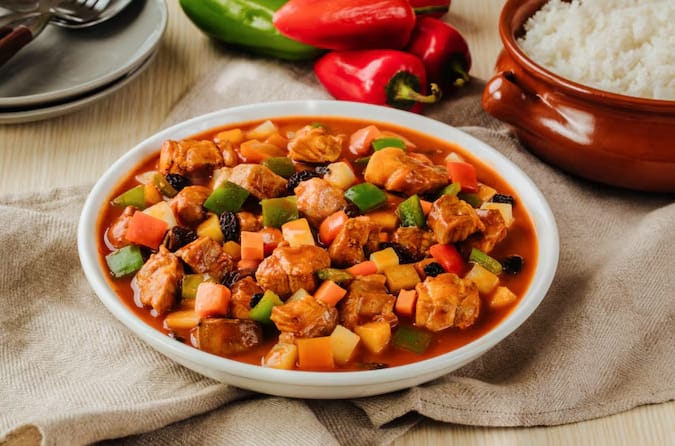
Introduction
Pork Menudo is a beloved Filipino stew packed with tender pork, liver, potatoes, carrots, and bell peppers simmered in a rich tomato-based sauce. This dish is a staple in Filipino households and is often served during special gatherings, family dinners, and fiestas. In this recipe, we’ll guide you through making the perfect pork menudo.
Why You’ll Love This Pork Menudo Recipe
✅ Authentic Filipino Taste – Made with classic ingredients that bring out the best flavors.
✅ Easy to Cook – Simple step-by-step guide perfect for beginners and home cooks.
✅ Perfect for Any Occasion – Great for family meals or special celebrations.
✅ Meal Prep Friendly – Stores well for leftovers and weekly meal planning.
Ingredients
To create the best pork menudo, gather these fresh and high-quality ingredients:
Main Ingredients:
- 1 kg (2.2 lbs) pork shoulder, cut into small cubes
- 250g (½ lb) pork liver, cut into small cubes (optional but adds richness)
- 2 medium potatoes, peeled and diced
- 1 large carrot, peeled and diced
- 1 red bell pepper, diced
- 1 green bell pepper, diced
- 1 cup green peas
- 3 cloves garlic, minced
- 1 medium onion, chopped
- 2 large tomatoes, chopped
- 2 cups tomato sauce
- 1 cup water or chicken broth
- 2 tbsp soy sauce
- 1 tbsp fish sauce (patis)
- 1 tbsp sugar (adjust to taste)
- 1 tsp ground black pepper
- 2 tbsp cooking oil
Optional Add-ons:
- 1 cup raisins (for a slightly sweet balance)
- 1 bay leaf (for extra aroma)
- 1 tbsp Worcestershire sauce (adds depth of flavor)
Step-by-Step Cooking Instructions
Step 1: Prepare the Ingredients
- Cut the pork and liver into uniform, bite-sized pieces for even cooking.
- Dice the vegetables and set them aside in separate bowls.
Step 2: Sauté the Aromatics
- Heat cooking oil in a pan over medium heat.
- Sauté the garlic until golden brown, then add the onions and cook until translucent.
- Add the chopped tomatoes and cook until soft and mushy.
Step 3: Brown the Pork
- Add the pork cubes to the pan and sauté until lightly browned.
- Pour in the soy sauce and fish sauce, stirring well to coat the meat.
- Let it simmer for 3-5 minutes to absorb the flavors.
Step 4: Simmer in Tomato Sauce
- Pour in the tomato sauce and water (or broth), then stir to combine.
- Cover and let it simmer over low heat for 30-40 minutes or until the pork is tender. Stir occasionally.
Step 5: Add the Vegetables and Liver
- Toss in the diced potatoes and carrots. Simmer for another 10 minutes.
- Add the pork liver and cook for 5 minutes, stirring occasionally.
- Stir in the bell peppers, green peas, and raisins (if using). Simmer for 3-5 more minutes until the vegetables are tender but not overcooked.
Step 6: Final Seasoning and Serving
- Taste and adjust the seasoning with black pepper, sugar, or more fish sauce if needed.
- Serve hot with steamed rice and enjoy your homemade Pork Menudo!
Pro Tips for the Best Pork Menudo
🔥 Use Pork Shoulder or Pork Belly – These cuts stay tender and juicy after simmering.
🔥 Don’t Overcook the Liver – Add it in the last 5 minutes to prevent it from becoming tough.
🔥 Balance the Flavors – Adjust sweetness with raisins and sugar according to your taste.
🔥 Use Fresh Tomatoes – Adds a natural depth of flavor that enhances the tomato sauce.
Frequently Asked Questions (FAQs)
1. Can I make pork menudo without liver?
Yes! You can omit the liver if you prefer a milder taste. The dish will still be delicious.
2. How do I store leftover menudo?
Store leftovers in an airtight container and refrigerate for up to 3-4 days or freeze for up to 3 months.
3. What is the best side dish for menudo?
Pork menudo is best served with steamed white rice. You can also pair it with pandesal or garlic rice.
4. Can I cook pork menudo in a slow cooker?
Yes! Sauté the aromatics and brown the pork first, then transfer everything to a slow cooker and cook on low for 6-8 hours or high for 3-4 hours.
Final Thoughts
This authentic Filipino Pork Menudo recipe brings warmth and nostalgia to any meal. Its combination of rich tomato sauce, tender pork, and vibrant vegetables makes it an all-time favorite. Whether you’re cooking for a family dinner or meal prepping for the week, this recipe is guaranteed to impress.
